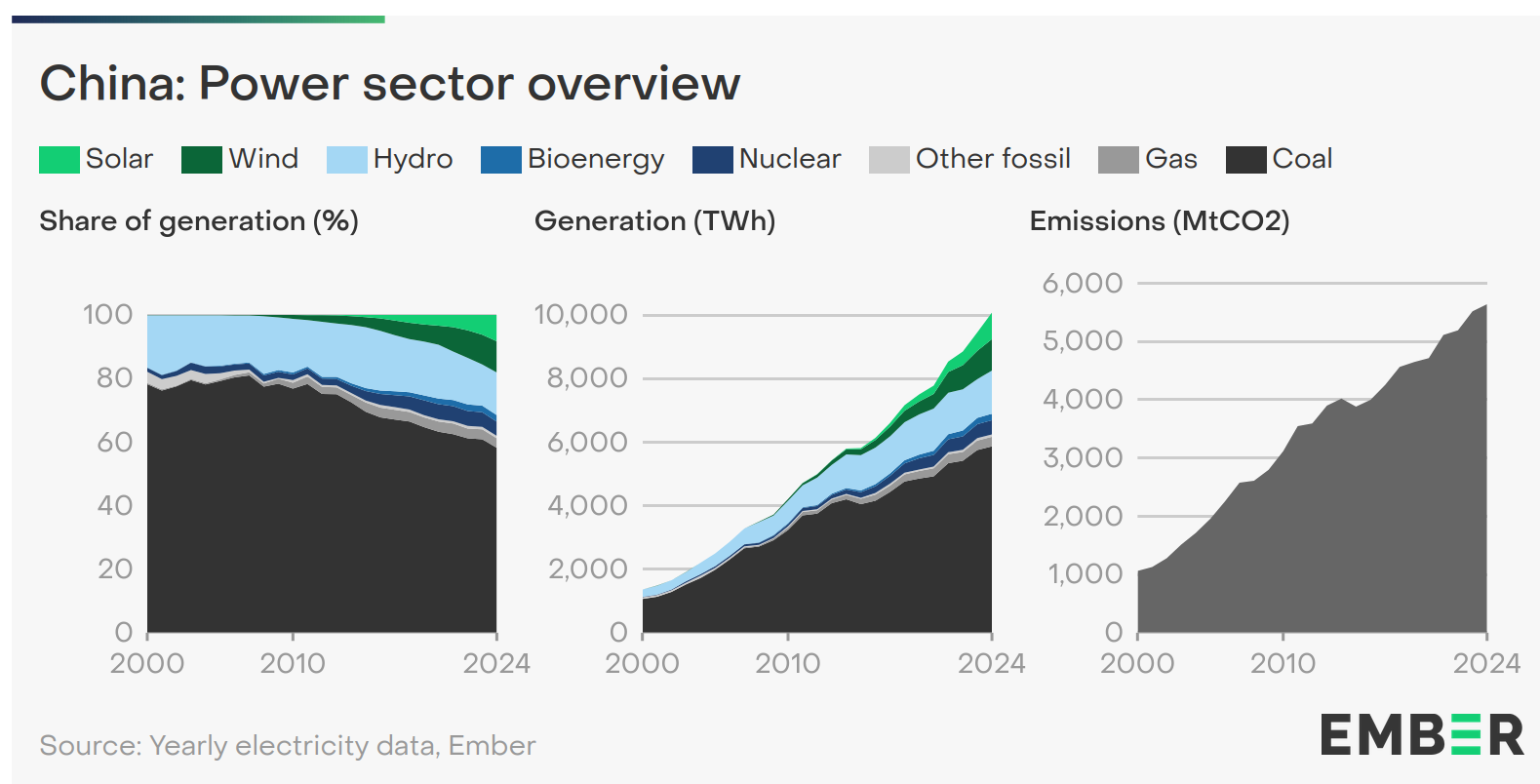Last year China generated almost 3 times as much solar power as the EU did, and it's close to overtaking all OECD countries put together (whose combined population is 1.38 billion people)
-
Last year, China generated 834 terawatt-hours of solar power.
Which is more than the G7 countries generated, and more than the US and EU combined. In fact the only country group that generates more solar power than China is the OECD, all 38 countries of it.
Data:
@ember-energy.orgSource: https://bsky.app/profile/nathanielbullard.com/post/3lsbbsg6ohk2j
Yeah I tracked it back to that, but couldn't find the graph shown and had no knowledge of the ember.
Having said that, I'm all for the green revolution and would love to see it go harder. As a petrol head the idea of guilt free fuel is like a holy grail
-
Yeah I think by "source" they just mean they're just giving credit to the bsky post they got the graph from, the data seems to be from a green energy transition thinktank. No idea if you'd put more stock in ember-energy.org/, so make of that what you will

 ️
️From the website:
Data into action
Open data and intelligent policy analysis to unlock a clean, electrified energy future
Yeah, that's where I ended up and didn't know what to do with them. I guess I trust them as much as any unknown internet source
-
How idiotic.
Do explain, I'm all ears.
-
Last year, China generated 834 terawatt-hours of solar power.
Which is more than the G7 countries generated, and more than the US and EU combined. In fact the only country group that generates more solar power than China is the OECD, all 38 countries of it.
Data:
@ember-energy.orgSource: https://bsky.app/profile/nathanielbullard.com/post/3lsbbsg6ohk2j
Nice I love seeing China Greenwashing get reposted. Remember that China is 3x the size of the EU so them having 3x the solar power is a stupid comparison. China also continues to increase coal generation by more than renewables. China is only %27 renewables while the EU is 47%. China is 17% of the world and almost 40% of the emissions.
OECD countries are actually working on emission reduction instead of china which continue to increase emissions with absolute no signs of stopping. They have missed every single renewable target and goal they're set. But dont worry im sure they will stop building more coal plants in 2030, im sure it wont be to late by then.
-
Nice I love seeing China Greenwashing get reposted. Remember that China is 3x the size of the EU so them having 3x the solar power is a stupid comparison. China also continues to increase coal generation by more than renewables. China is only %27 renewables while the EU is 47%. China is 17% of the world and almost 40% of the emissions.
OECD countries are actually working on emission reduction instead of china which continue to increase emissions with absolute no signs of stopping. They have missed every single renewable target and goal they're set. But dont worry im sure they will stop building more coal plants in 2030, im sure it wont be to late by then.
While everyone else is paying the costs that come with environmental regulation china is exploiting it and getting celebrated for it. Its insane what a few dollars can do to change peoples minds on a topic.
-
Do explain, I'm all ears.
I think they don't get that your comment is fighting the same fight by being pro solar & anti coal/gas.
Unless you meant keeping the coal and gas plants, which really should be turned off and ended at this point. They're just sources of lung cancer & emissions
-
Nice I love seeing China Greenwashing get reposted. Remember that China is 3x the size of the EU so them having 3x the solar power is a stupid comparison. China also continues to increase coal generation by more than renewables. China is only %27 renewables while the EU is 47%. China is 17% of the world and almost 40% of the emissions.
OECD countries are actually working on emission reduction instead of china which continue to increase emissions with absolute no signs of stopping. They have missed every single renewable target and goal they're set. But dont worry im sure they will stop building more coal plants in 2030, im sure it wont be to late by then.
tbh I'm surprised that you even got upvotes, didn't went that well for me with a similar answer on another post...
-
I think they don't get that your comment is fighting the same fight by being pro solar & anti coal/gas.
Unless you meant keeping the coal and gas plants, which really should be turned off and ended at this point. They're just sources of lung cancer & emissions
Yes, of course I've meant it in a positive way - a way to replace coal and gas. But solar is not just positive, they are problematic when you couple them with nuclear for the simple reasons that solar is not reliable and you can't throttle nuclear - they are like big ships, they require a lot of time to steer. Furthermore solar energy low price causes problems for nuclear higher prices. Which wouldn't be a problem if solar was reliable and continuous (long winter nights much?). But it's not, but you still need a reliable energy source. And so on.
The pro solar panel crowd don't understand many of these implications and go with simple "idiotic" and downvotes. -
Yep, solar is awesome when you have coal and gas power plants, not so much when you have nuclear ones.
Solar and nuclear work just fine together. Nuclear is expensive (and most cost effective if kept running all the time, rather than switched on and off) but it reduces the cost of solar (lower proportion of solar means you don't need as much storage) and hedges against bad weather.
-
tbh I'm surprised that you even got upvotes, didn't went that well for me with a similar answer on another post...
Yeah the .ml must have missed this thread.
-
Nice I love seeing China Greenwashing get reposted. Remember that China is 3x the size of the EU so them having 3x the solar power is a stupid comparison. China also continues to increase coal generation by more than renewables. China is only %27 renewables while the EU is 47%. China is 17% of the world and almost 40% of the emissions.
OECD countries are actually working on emission reduction instead of china which continue to increase emissions with absolute no signs of stopping. They have missed every single renewable target and goal they're set. But dont worry im sure they will stop building more coal plants in 2030, im sure it wont be to late by then.
China also continues to increase coal generation by more than renewables.
I don't believe this:


China | Energy Trends | Ember
Explore the latest data on China’s energy transition. How clean is China's electricity? How much renewable electricity does China generate?

Ember (ember-energy.org)
In 2024, China approved 66.7GW of new coal-fired capacity, started construction on 94.5GW of coal power projects
Even if you add these 2 together and pretend they were finished the same year it's not even close to:
China’s renewable energy sector made remarkable progress in 2024, adding 356 gigawatts (GW) of wind and solar capacity

China’s Energy Production: Coal and Renewables Locked in Competition Amid Clean Energy Boom
China’s energy production strategy in 2024 has been marked by both an unprecedented surge in renewable energy and a persistent reliance on coal, according to a new analysis by two think tanks, the Global Energy Monitor and the Centre for Research on Energy and Clean Air (CREA).

The Asia Live (theasialive.com)
They have missed every single renewable target and goal they’re set.
I don't believe this is true either unless you are referring to some other targets?
In 2020, China set a goal to install at least 1,200 gigawatts (GW) of solar and wind power by 2030. By the end of 2024, China had already surpassed this target, reaching this milestone 6 years ahead of schedule. This was made possible by aggressive investments, government policies, and a surge in solar and wind installations.
China’s solar capacity grew by an incredible 45.2% in 2024, adding 277 GW. Wind capacity also saw a strong increase of 18%, with an additional 80 GW installed. Overall, total power generation capacity rose by 14.6% in 2024, driven mainly by renewables.

China’s Renewable Energy Boom: A Record-Breaking Shift or Still Chained to Coal?
China has surpassed its 2030 renewable energy goal six years early, leading global clean energy growth. But coal reliance remains a challenge.

Carbon Credits (carboncredits.com)
China is only %27 renewables while the EU is 47%.
Don't worry, just like everything else I'm sure that will flip in the future
Europe has plenty of money apparently to suddenly:
NATO leaders on Wednesday confirmed their commitment to more than double defence spending by 2035 banding words like "crucial", "momentous" and "quantum leap"

Defence up to 5% GDP, Ukraine, Russia: Key takeaways from NATO summit
The summit ended with a commitment to spend 5% of GDP on defence - more than double the current target of 2%.

euronews (www.euronews.com)
Just why does it take an emergency to make some proper progress:
Global energy storage owner-operator BW ESS and Spanish energy storage developer Ibersun say a new joint venture is intended to build eight four-hour battery projects across the country, with a combined capacity of 2.2 GW, 8.8 GWh.

“No time to waste:” Huge big battery plans unveiled for Spain as accusations traded over blackout
Two battery storage companies unveil plans for eight big projects in Spain, as the government, regulator and power companies trade accusations over cause of blackout.

RenewEconomy (reneweconomy.com.au)
Where will the batteries be made I wonder?
On top of this energy prices in the EU are ridiculous and for some reason they still can't get off the gas, which leads to an unreal point of France giving more money to Russia for gas than in aid to Ukraine, so they have high energy prices and they're funding Russia's invasion of Ukraine and their companies and manufacturing are leaving them... to go to China...

Eurozone business activity almost flat again in June - Aussie Zone
> “The eurozone economy is struggling to gain momentum. For six months now, growth has been minimal, with activity in the service sector stagnating and manufacturing output rising only moderately,” Cyrus de la Rubia, chief economist at Hamburg Commercial Bank. >“In Germany, there are signs of a cautious improvement in the situation, but France continues to drag its feet”. >The expansion in the 20-country currency area was centred on the manufacturing sector, where production increased for the fourth successive month, according to the survey.

(aussie.zone)
But I appreciate your scepticism (I gave your post an upvote because China does sometimes get a little bit too much credit), they are the worlds top producer of CO2 by FAR but I do want to address
Greenwashing
This is something I've wanted for a while:
It requires EU importers to pay a levy corresponding to the embedded carbon emissions in 303 emission-intensive products
I've long disliked that places like the EU and the rest of the west can export their dirty manufacturing over to China where companies take advantage of lax or no environmental regulations, it's a false economy and makes the west look a whole lot greener and cleaner than it would if we were manufacturing what we used back at home
‘China has Apple by the balls’: How the rising superpower captured the tech giant
‘China has Apple by the balls’: How the rising superpower captured the tech giant
Apple Inc reaped staggering profits by outsourcing its manufacturing – but its “epic” technology transfer has consequences, says one long-time observer.
The Sydney Morning Herald (www.smh.com.au)
edit: boy I sure do love to procrastinate and talk about energy and co2 instead of studying

-
Good on them. The earlier they can shut down those coal plants, the better.
They‘ll keep building more coal power plants in the global south and export coal. There‘s a lot of money to be made.
-
Solar and nuclear work just fine together. Nuclear is expensive (and most cost effective if kept running all the time, rather than switched on and off) but it reduces the cost of solar (lower proportion of solar means you don't need as much storage) and hedges against bad weather.
You can't just switch it off and on. It runs at more or less full power all the time. So tell me, at what power is that taking into consideration that sun doesn't shine during night + mornings and evenings when days are short or cloudy?
-
You can't just switch it off and on. It runs at more or less full power all the time. So tell me, at what power is that taking into consideration that sun doesn't shine during night + mornings and evenings when days are short or cloudy?
I don't understand what you're asking, sorry.
-
Last year, China generated 834 terawatt-hours of solar power.
Which is more than the G7 countries generated, and more than the US and EU combined. In fact the only country group that generates more solar power than China is the OECD, all 38 countries of it.
Data:
@ember-energy.orgSource: https://bsky.app/profile/nathanielbullard.com/post/3lsbbsg6ohk2j
People talk about China's energy use like it's not* their* energy use. They used that power to produce the stupid shit that you bought, dumbass. You're responsible for that energy use, despite it being generated in China.
-
I don't understand what you're asking, sorry.
The question is simple. If you have installed solar power of 40% your country peak use, how much nuclear power you need - assuming simplified you have only these two power sources.
-
Last year, China generated 834 terawatt-hours of solar power.
Which is more than the G7 countries generated, and more than the US and EU combined. In fact the only country group that generates more solar power than China is the OECD, all 38 countries of it.
Data:
@ember-energy.orgSource: https://bsky.app/profile/nathanielbullard.com/post/3lsbbsg6ohk2j
It is strategic necessity for China for energy security and for their own environment. Their predominant source of electricity has been coal which they have abundant of but is polluting the air they breathe. Does anyone recall the issues they had at Beijing Olympics? They have insufficient sources of oil and gas domestically. Alternative energy sources are their best domestic source of energy.
-
I'm curious how much of it they consumed though. I read recently the UK keeps on paying Wind farms (for example) to NOT supply the grid as they don't need it at certain times, and it wasn't going into batteries for later either. Just generated and...gone?
They pay the windfarms when too much power is generated for the grid to handle. The wind turbines are then throttled accordingly and the windfarm owners are reimbursed for the lost potential. At least that's how it goes in Germany. It's kind of an incentive to upgrade the power grid.
-
Do explain, I'm all ears.
No. I type less.
-
I think they don't get that your comment is fighting the same fight by being pro solar & anti coal/gas.
Unless you meant keeping the coal and gas plants, which really should be turned off and ended at this point. They're just sources of lung cancer & emissions
No. We get exactly what his comment is about.
If he was in the renewables camp, there would be no point, in this discussion over solar, to bring up nuclear. It's absolutely unrelated.
What he's doing is pushing the thought into people's heads that nuclear is a good solution, and that's why I'm calling him out for. For being a shill.






